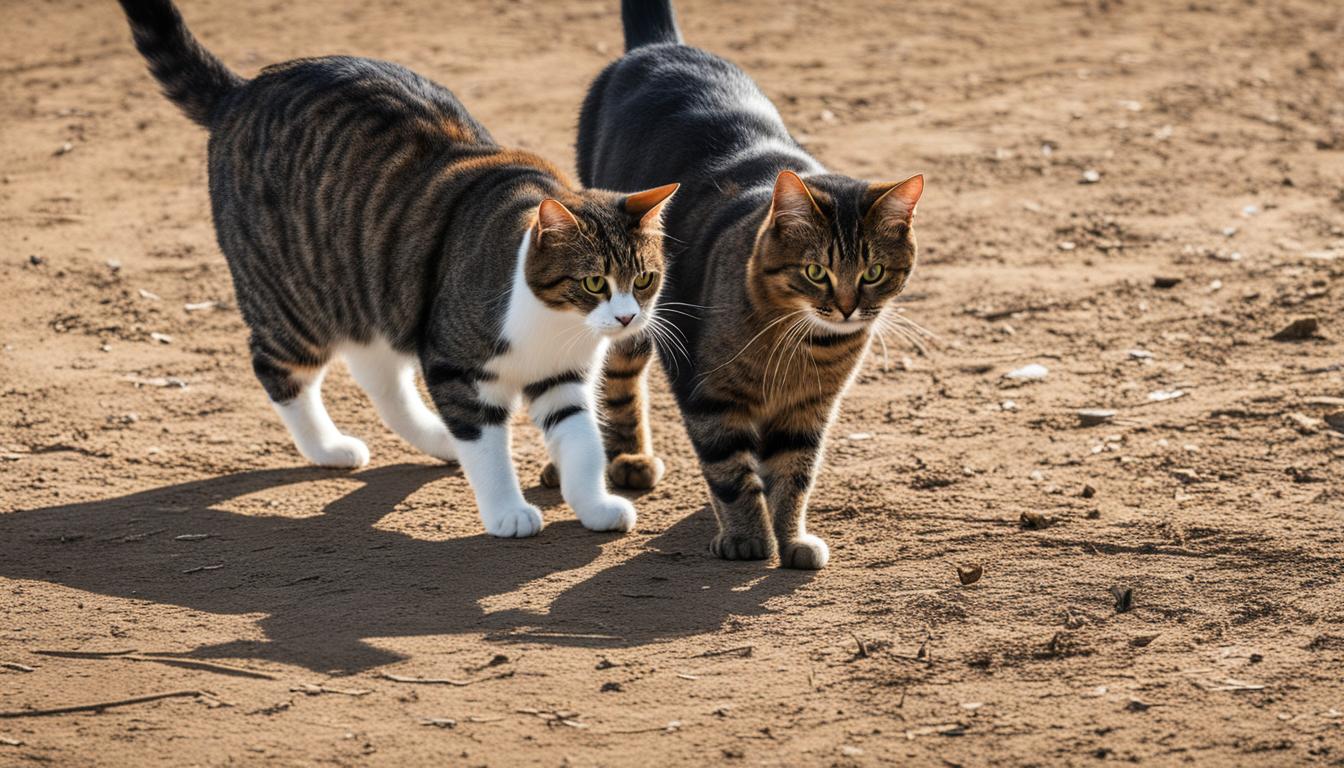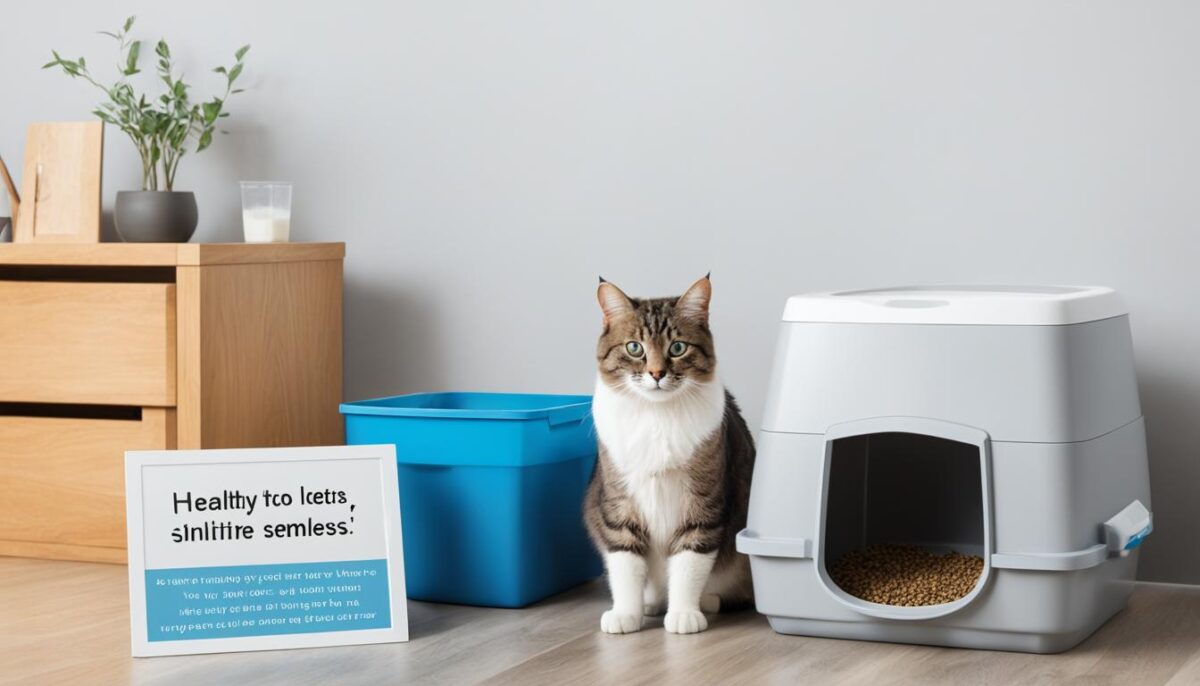Have you noticed your furry friend doing their business outside the kitty litter box? You might wonder why they are doing this. Well, there’s a big chance that they are either spraying or peeing for reasons you need to understand. Let’s talk about what these behaviors mean and how they can affect your life together. Spraying is a way cats talk to each other with scents. They spray to claim their space. Peeing outside the litter box might mean your cat is upset, or something else is going on.
Knowing the difference between the two can help you figure out the best way to help your cat. It’s important to keep an eye on your pet’s habits because changes could point to health problems or feeling stressed. Remember, both male and female cats might spray. If you make sure their litter box is clean and placed where they like it, you’re doing a great job as a pet owner. But if you see them spraying or not using the litter box, it might be time to look deeper into what’s up with your cat.
Key Takeaways
- Spraying is how cats mark their area and talk to other cats without words.
- Peeing outside the litter box might mean your cat is unhappy or not feeling well.
- Both boy and girl cats spray, and it has a lot to do with claiming territory.
- Taking care of your cat’s litter box can prevent many pee problems.
- If your cat starts to spray or avoids using the litter box, it’s time to understand what they need.
- Remember, fixing litter box issues helps keep both you and your cat happy.
Understanding Your Cat’s Bathroom Behaviors
Cats do some pretty neat things, and one of them is how they tell other cats “This is my place!” They don’t use words like we do; they use something called urine marking.
Defining Cat Spraying and Its Purposes
When your cat sprays, think of it like they’re writing a note to other cats but using smell instead of words. They stand up, lift their tail high, and spray pee on something like a wall. It’s their way of saying, “Hey, I live here!” This is a big part of cat communication and is pretty normal for them.
Difference Between Spraying and Peeing
Spraying and peeing are not the same thing, kind of like saying “Hi” versus having a full conversation. A cat that’s spraying is actually having a little chat with other cats without seeing them. Peeing is more about, well, just going to the bathroom. You’ll see your cat squat if they’re peeing. It’s a more chill thing they do when they’re not trying to send messages.
Common Reasons Cats Pee Outside the Litter Box
Sometimes cats might not pee in their litter box, and it’s not because they’re trying to be naughty. They might not feel good, they might be sore, maybe they don’t like how the litter feels, or the box is too small. It’s like if you had to wear scratchy socks or your shoes were tight – you wouldn’t like that. Cats feel the same about their boxes.
Feline territorial behavior is pretty fascinating, which is why they sometimes spray to say “This is my zone!” They might do it if there are new people, pets, or even furniture in their house.
If your cat is avoiding their litter box, it’s like a puzzle you have to solve. Think about how you can make their bathroom spot feel safe, comfy, and just right for them. When you figure it out, they’ll probably start using it again. Remember, talking to a vet can always help you understand your cat better, especially if they’re not feeling well.
Cat Spraying vs Peeing: Deciphering the Signs
Hey there! If you want to figure out if your kitty is spraying or peeing, it’s important to know the signs. Spraying means your cat stands up, their tail may shake, and they spray a vertical line of pee. They do this to chat with other cats without making a sound. It’s like leaving a note for friends! Peeing, though, is just when your cat needs to go potty. They’ll squat and leave a puddle, usually on a flat surface. Sometimes they try to hide it by scraping around it.
Understanding these distinguishing cat behaviors and feline urine signs can help you know what to do to help your cat. Here’s a cool trick: where they go can give you clues. If it’s up high, they’re probably spraying. If it’s on your carpet or their bedding, they just needed to pee.
Take a look at this easy table to see the differences. It can help you tell what’s going on with your cat:
| Behavior | Posture | Location | Urine Spot Shape | Trying to Cover? |
|---|---|---|---|---|
| Spraying | Standing with tail shaking | Vertical surfaces (like walls) | Line or stream | No |
| Peeing | Squatting | Horizontal surfaces (like floors) | Puddle | They might try! |
Once you know these signs, you can help your cat be happy and healthy. Plus, you might save your couch or carpet from an “accident”! Remember, if you’re ever not sure or worried about your cat, it’s always a good idea to talk to your vet. They’ll have great advice for you and your furry friend!
Reasons Behind Spraying: Stress, Territoriality, and Mating
When your cat sprays, you might wonder why it’s happening. It could be because your cat feels worried or scared. Think about when you feel nervous and might tap your foot or chew your nails. Cats spray to feel better when they feel stress. Big changes like moving or a new pet in the house can make your cat spray more. Cats use spray to leave messages for other cats too, kinda like how you leave notes for your friends.
Emotional Triggers and Scent Communication
Just like you feel better talking to your friends when you’re scared, cats spray to talk to other cats. It’s their way of saying, “Hey, I’m here, this is my spot!” Remember, spraying is talking for them, especially when they’re feeling stressed or scared.
How Territorial Feelings Influence Spraying
Imagine if you had to share your favorite toy with others. You might get a little upset, right? Cats feel the same about where they live. When they spray, they’re telling other cats, “This place is mine!” If there are lots of cats at home, they may spray more to tell each other “I’m the boss here!”
The Role of Hormones in Feline Spraying Behaviors
Did you know that just like people, cats have feelings that can make them spray? If cats are not spayed or neutered, which means they can have kittens, they might spray because of these feelings. Even after they can’t have kittens anymore, some cats might still spray if they’re feeling tense or want to be the boss.
Medical Conditions That Influence Feline Soiling
When your cat starts going to the bathroom in places other than their litter box, it might be a sign that something is not right. It’s important to look for other signs or changes in their behavior that might tell you they don’t feel well. Seeing your vet is a good step to make sure your cat is healthy.
Identifying Potential Health Issues
If your kitty is having bathroom troubles, it might be because of a health problem. Things like a urinary tract infection, which can make peeing painful, or arthritis, which can make it hard for your cat to climb into their litter box, could be causing the issue. We need to watch for behavioral symptoms that show our furry friends are not feeling their best.
How Medical Treatments Can Reduce Inappropriate Soiling
Once the vet figures out what’s wrong, they can start making your cat feel better. Whether it’s medicine for a feline urinary health issue or some extra care for sore joints, getting the right treatment can help. When cats are not in pain, they are more likely to use their litter box as they should.
| Signs to Watch For | What It Could Mean | What You Can Do |
|---|---|---|
| Going to the bathroom in new places | Possible urinary issue | Check with your vet for advice |
| Licking their lower belly a lot | Could be stress or a health worry | Soft pets and a vet trip can help |
| Not wanting to jump | Maybe sore joints or arthritis | Gentle plays and checkup time |
| Looking sad and sleeping more | Could be feeling sick | Comforting cuddles and vet care |
If your cat is spraying or having accidents, it’s not because they are bad. They might just be telling you in their own way that they need help. Remember, they love being clean and using their box, so when they don’t, it’s a big clue for you to give them a little extra attention and care.
Creating a Conflict-Free Environment for Your Cats
Do you have more than one cat at home? If yes, you know how important it is for everyone to get along. When cats get upset, they might spray or pee where they shouldn’t. To keep your kitty family happy, you can do some simple things to make sure there’s no fighting and keep the peace. You want to aim for multi-cat household harmony and focus on reducing feline aggression.
First, make sure each cat has their own stuff. They need their own food bowl, water bowl, and litter box. This helps them feel safe because they don’t have to share with others if they don’t want to. Just like you might not like someone else eating from your plate, cats don’t either!
Then, give them places to hang out and relax. Cats like high spots to look around and cozy corners to nap. When they have such places, it makes them feel better and they won’t feel the need to fight over their favorite spot on the couch.
Also, think about using things that make cats feel relaxed. Some people use plugins that smell good to cats, but not to us. They help cats feel less scared and more chill.
Here’s a table showing what every cat should have in a house with many cats. This can help keep arguments between cats away and makes sure everyone feels they have enough of what they need:
| What Cats Need | How Many Per Cat | Why It’s Important |
|---|---|---|
| Litter Boxes | 1+ per cat | Helps avoid fighting over where to go potty |
| Food Bowls | 1 per cat | Every cat can eat without worry |
| Water Bowls | 1+ per cat | Stops arguments and makes sure all cats drink enough |
| Resting Spots | Several per house | Gives cats their own space to relax |
| Toys | Lots! | Keeps cats busy and happy so they won’t pick fights |
Remember, a happy cat is one that feels safe. By giving each cat what they need and making sure they have their own space, you can help stop fights before they start. And that means no unwanted spraying or peeing. You’ll all be happier for it!
Practical Tips for Managing and Correcting Undesirable Behaviors
When it comes to your feline friends, sometimes they can have some messy habits. But don’t worry, we’ve got some super helpful tips to make things better. Let’s dive into the smart ways you can clean up and stop these little accidents from happening again!
Proper Cleaning Techniques for Sprayed and Soiled Areas
Cleaning up after your cat has marked its territory doesn’t have to be tough. Start by using enzymatic cleaners that are made just for cleaning cat urine. These special cleaners break down the urine and make the smell go away so your cat doesn’t pee in the same spot.
Remember, using strong cleaners with harsh smells can make your cat want to mark the area even more. Stick to mild soapy water followed by these cool enzymatic cleaners, and you’ll be all set! It’s like an 8-step magic trick to keep your home smelling fresh and clean.
Modifying the Environment to Prevent Future Incidents
Got more than one kitty? Give each one their own litter box plus one extra. Place them in quiet, comfy spots so each cat feels safe. Think about using baby gates to give your cats their own areas. This can keep them calm and stop them from getting into each other’s space.
Behavioral Training to Redirect Spraying and Peeing
Positive actions work wonders with cats! Guide them to scratch posts so they can mark their territory the right way. Playtime is also great for making your cats happy and stopping them from misbehaving. And when they do things right, give them that little treat they love. This way, they know they’re doing something good!
By cleaning spots properly, making your home a kitty paradise, and guiding them with sweet rewards, you’ll be a pro at stopping these spraying and peeing problems. High-paw for being an awesome cat owner!
Conclusion
When you know the difference between your cat’s spraying and peeing, you’re on your way to managing feline elimination better. It’s like being a detective. You look for clues. Does your cat stand and spray on walls? Or do they squat and pee on the floor? Once you figure this out, you can help them. You give them a great place to live, you make sure they’re healthy, and you clean up right if they mark their space.
Remember, if you keep their litter box clean and their home happy, they will be happier too. And if they ever feel sick, a quick trip to the vet can solve many potty problems. Working together with your cat makes positive cat ownership a win for both of you. It helps to stop those wet surprises and keeps your home smelling fresh. This is how you and your cat can live in pee-ace and harmony!
So, if you follow these steps and keep learning about your furry friend, you’ll have fewer messes and more good times. Take care of them and they’ll love you even more. That’s what being a great cat owner is all about!
FAQ
What’s the difference between cat spraying and peeing?
Cat spraying is a form of territorial marking where a cat releases a small amount of urine on vertical surfaces to communicate with other cats. Peeing, on the other hand, is simply the act of a cat emptying its bladder, usually on horizontal surfaces, and may attempt to bury it afterward.
Why is my cat peeing outside of the litter box?
Your cat might pee outside of the litter box for various reasons such as litter box aversion due to cleanliness, discomfort from feline medical conditions, stress, or preference for a different substrate. It’s essential to rule out health issues and evaluate the litter box’s condition and location.
Can spraying be a sign of a health issue in cats?
Yes, spraying can sometimes be a sign of health issues. Conditions like cystitis, urinary tract infections, or stress-related medical conditions can lead to spraying. If your cat starts spraying suddenly, it’s important to have them checked by a veterinarian to rule out any health problems.
How do emotional triggers lead to cat spraying?
Cats may spray because of emotional triggers such as stress, anxiety, or fear. Changes in their environment, the introduction of new pets or people, or alterations in their routine can lead to an increase in spraying as a means for cats to cope and mark their territory.
What are some methods to reduce or eliminate spraying and peeing in inappropriate places?
To reduce or stop your cat from spraying or peeing in inappropriate places, ensure their environment is stress-free and comfortable. Use enzymatic cleaners to remove urine odors, provide multiple litter boxes, and establish a routine. Behavior modification and environmental changes can also be effective strategies.
Is it only male cats that spray?
No, both male and female cats can spray, especially if they are not spayed or neutered. Spraying is linked to hormonal behavior, and while neutering or spaying can reduce spraying, it may not eliminate it entirely if other factors, such as stress, are at play.
How can I tell if my cat is spraying and not just peeing?
You can tell if your cat is spraying by observing their posture and the location of the urine. A cat that is spraying will typically stand up straight and may quiver their tail while releasing a stream of urine against a vertical surface. In contrast, peeing usually occurs on flat surfaces with the cat in a squatting position.
Does neutering or spaying help with cat spraying?
Neutering or spaying can help reduce spraying behavior, as it decreases the influence of hormones that drive territorial and mating behaviors. However, it’s not a guaranteed fix for all cats, as spraying can also be prompted by stress or territory disputes.
What role does territorial behavior play in cat spraying?
Territorial behavior plays a significant role in cat spraying. Cats use urine marking as a way to communicate with other cats and to establish their territory. If a cat feels their space is being threatened or they need to assert their dominance, they may resort to spraying.
How should I clean areas that my cat has sprayed or soiled?
Clean sprayed or soiled areas with an enzymatic cleaner, which helps break down the urine and remove the odor. Avoid ammonia-based cleaners as their scent can mimic that of urine and may encourage your cat to mark the area again.


